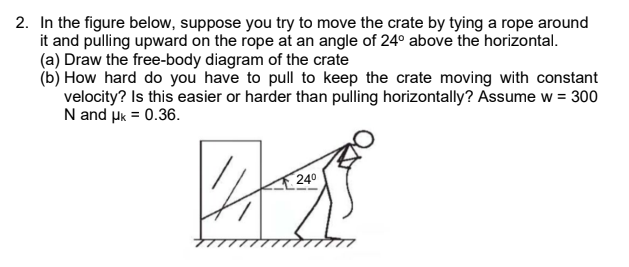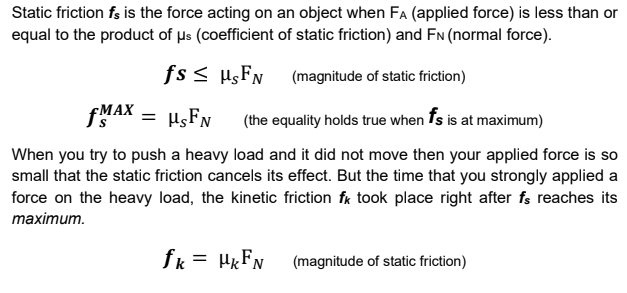2. In the figure below, suppose you try to move the crate by tying a rope around it and pulling upward on the rope at an angle of 24° above the horizontal. (a) Draw the free-body diagram of the crate (b) How hard do you have to pull to keep the crate moving with constant velocity? Is this easier or harder than pulling horizontally? Assume w = 300 N and uk = 0.36. 240
2. In the figure below, suppose you try to move the crate by tying a rope around it and pulling upward on the rope at an angle of 24° above the horizontal. (a) Draw the free-body diagram of the crate (b) How hard do you have to pull to keep the crate moving with constant velocity? Is this easier or harder than pulling horizontally? Assume w = 300 N and uk = 0.36. 240
College Physics
1st Edition
ISBN:9781938168000
Author:Paul Peter Urone, Roger Hinrichs
Publisher:Paul Peter Urone, Roger Hinrichs
Chapter5: Further Applications Of Newton's Laws: Friction, Drag, And Elasticity
Section: Chapter Questions
Problem 4PE: Suppose you have a 120-kg wooden crate resting on a wood floor. (a) What maximum force can you exert...
Related questions
Question
Our topic is STATIC AND KINETIC FRICTION. Give a detailed explanation and clear image for the solution. I add formula together with the problem if it can make it a lot easier for you to answer it but if its not related to the problem, kindly disregard it. Thank you.

Transcribed Image Text:2. In the figure below, suppose you try to move the crate by tying a rope around
it and pulling upward on the rope at an angle of 24° above the horizontal.
(a) Draw the free-body diagram of the crate
(b) How hard do you have to pull to keep the crate moving with constant
velocity? Is this easier or harder than pulling horizontally? Assume w = 300
N and uk = 0.36.
240

Transcribed Image Text:Static friction fs is the force acting on an object when FA (applied force) is less than or
equal to the product of µs (coefficient of static friction) and FN (normal force).
fs < µsFN (magnitude of static friction)
FMAX
(the equality holds true when fs is at maximum)
When you try to push a heavy load and it did not move then your applied force is so
small that the static friction cancels its effect. But the time that you strongly applied a
force on the heavy load, the kinetic friction fk took place right after fs reaches its
таxiтum.
fk = HKFN
(magnitude of static friction)
Expert Solution
This question has been solved!
Explore an expertly crafted, step-by-step solution for a thorough understanding of key concepts.
Step by step
Solved in 2 steps with 1 images

Recommended textbooks for you

College Physics
Physics
ISBN:
9781938168000
Author:
Paul Peter Urone, Roger Hinrichs
Publisher:
OpenStax College

Physics for Scientists and Engineers: Foundations…
Physics
ISBN:
9781133939146
Author:
Katz, Debora M.
Publisher:
Cengage Learning

Physics for Scientists and Engineers, Technology …
Physics
ISBN:
9781305116399
Author:
Raymond A. Serway, John W. Jewett
Publisher:
Cengage Learning

College Physics
Physics
ISBN:
9781938168000
Author:
Paul Peter Urone, Roger Hinrichs
Publisher:
OpenStax College

Physics for Scientists and Engineers: Foundations…
Physics
ISBN:
9781133939146
Author:
Katz, Debora M.
Publisher:
Cengage Learning

Physics for Scientists and Engineers, Technology …
Physics
ISBN:
9781305116399
Author:
Raymond A. Serway, John W. Jewett
Publisher:
Cengage Learning

College Physics
Physics
ISBN:
9781305952300
Author:
Raymond A. Serway, Chris Vuille
Publisher:
Cengage Learning

Physics for Scientists and Engineers with Modern …
Physics
ISBN:
9781337553292
Author:
Raymond A. Serway, John W. Jewett
Publisher:
Cengage Learning

Principles of Physics: A Calculus-Based Text
Physics
ISBN:
9781133104261
Author:
Raymond A. Serway, John W. Jewett
Publisher:
Cengage Learning